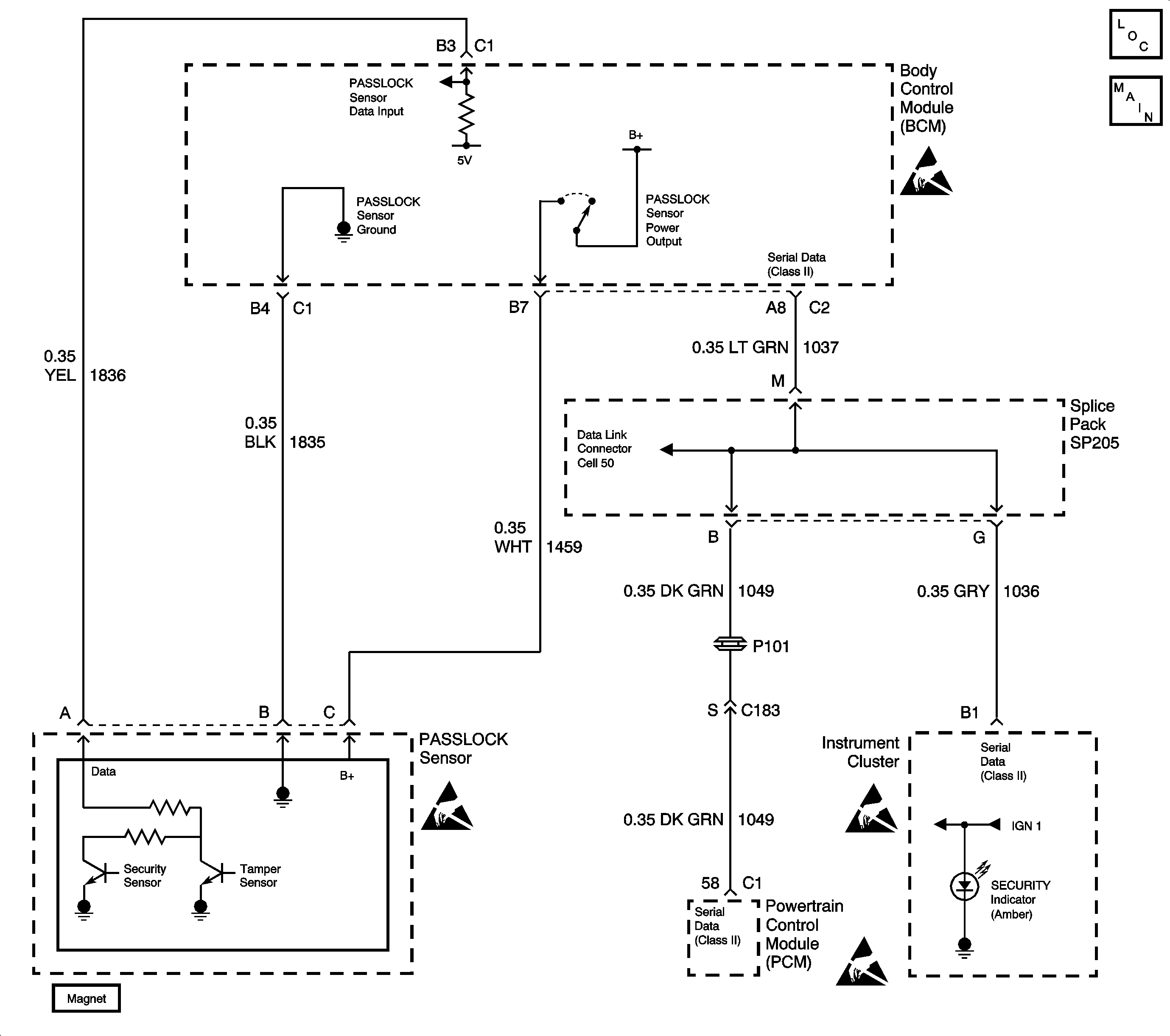
Circuit Description
The Passlock™ theft deterrent system contains a Passlock™ sensor. The Passlock™ sensor is part of the ignition lock cylinder assembly. The body control module (BCM) provides voltage (B+) to the Passlock™ sensor through circuit 1459 when the ignition switch is in the accessory, on, or start. The BCM also provides ground to the Passlock™ sensor through circuit 1835. The Passlock™ sensor interfaces with the BCM through the Passlock™ detection circuit 1836.
When turning the ignition switch to the start position with the proper key, the Passlock™ sensor generates an analog voltage signal. This signal is sent through the Passlock™ detecting circuit. This analog voltage signal is of a specific value to the vehicle, and varies from vehicle to vehicle. When attempting to start the engine, the BCM compares a preset stored analog voltage value with the signal coming from the sensor. Because both values match, the BCM sends a fuel enable password via the Class 2 serial data link to the powertrain control module (PCM). As a result, the PCM enables the crank relay, and allows fuel delivery to the engine.
When attempting to start the engine by means other than using the proper key in the ignition switch, the Passlock™ sensor sends a tamper signal. The BCM compares the preset stored analog voltage value with the signal coming from the sensor. Because both values do not match, the BCM sends a fuel disable password via the Class 2 serial data link to the powertrain control module (PCM). As a result, the PCM disables the crank relay, and stops fuel delivery to the engine.
Conditions for Setting the DTC
| • | The analog voltage signal sampled at the BCM's Passlock™ detection circuit is a tamper signal; indicating a Passlock™ tamper. |
| • | Condition must be present during an engine start attempt. |
Action Taken When the DTC Sets
When attempting to start the engine and the Passlock™ sensor sends a tamper signal, the BCM will take one of two actions:
| • | If the BCM programming mode is not active AND the BCM is not in fail enable mode, then: |
| - | Stores a DTC B3033 in the BCM memory. |
| - | Sends a message to the instrument cluster to flash the SECURITY indicator. |
| - | The BCM sends a message to the PCM via Class 2 serial data link to disable the crank relay, and stops fuel delivery to the engine. |
| - | Disables the sampling of the Passlock™ sensor analog voltage signal for a time-out period of ten minutes. |
| - | If the ignition switch is left on for at least ten minutes, the BCM enters the theft deterrent re-learn mode. |
| • | If the BCM programming mode is active AND the BCM is in fail enable mode, then: |
| - | Stores a DTC B3033 in the BCM memory. |
| - | Sends a message to the instrument cluster to turn on the SECURITY indicator. |
| - | The BCM will send a message to the PCM via Class 2 serial data link to enable the crank relay, and to deliver fuel to the engine; allowing the engine to crank and start. |
Conditions for Clearing the DTC
| • | A current DTC B3033 clears when the BCM detects a valid Passlock™ sensor analog voltage signal on the Passlock™ detection circuit 1836. |
| • | A history DTC will clear after 100 consecutive ignition cycles if the condition for the malfunction is no longer present. |
| • | Using a scan tool. |
Diagnostic Aids
| • | A faulty Passlock™ sensor may cause an intermittent malfunction to occur sensor. |
| • | If the SECURITY indicator is flashing, the BCM's Passlock™ has entered a vehicle disable state that will last approximately 10 minutes. Disconnecting the battery will not clear the timer sequence, it will resume when battery power is restored. Even if a proper Passlock™ sensor analog voltage signal is read during the vehicle disable period, the vehicle will not start until the ten minute time period has elapsed. After this ten minute time period, the SECURITY indicator will change from a flashing state to a solid on state. At this time, the BCM enters the theft deterrent re-learn mode. Also, the engine will start if the BCM detects the correct Passlock™ sensor analog voltage signal. |
| • | Check for poor connections at both the BCM and the ignition lock cylinder assembly, these could cause an open, incorrect Passlock™ sensor voltage signal, or intermittent malfunction. If the DTC is a history DTC, the problem may be intermittent. Try performing the tests shown while moving wiring, connectors, and the key, this can often cause the malfunction to appear. |
| • | DTC B2958 may set in the BCM when the ignition switch is on with the Passlock™ sensor electrical connector disconnected. When BCM diagnostics and repairs are completed for DTC B3033, clear BCM DTCs. |
Test Description
The number(s) below refer to the step number(s) on the diagnostic table.
-
Check if the tamper condition is currently present or is intermittent.
-
If this DTC resets after replacing the Passlock™ sensor, then the BCM is faulty.
Step | Action | Value(s) | Yes | No |
|---|---|---|---|---|
1 | Did you perform the Theft Deterrent Diagnostic System Check? | -- | ||
Does this DTC reset as a current DTC? | -- | |||
Does this DTC reset as a current DTC? | -- | System OK | ||
4 | Malfunction is intermittent and not present at this time. Refer to Diagnostic Aids for more information. Is the action complete? | -- | -- | |
5 |
Is the repair complete? | -- | -- | |
6 |
Are there any current BCM DTCs present? | -- | System OK |
